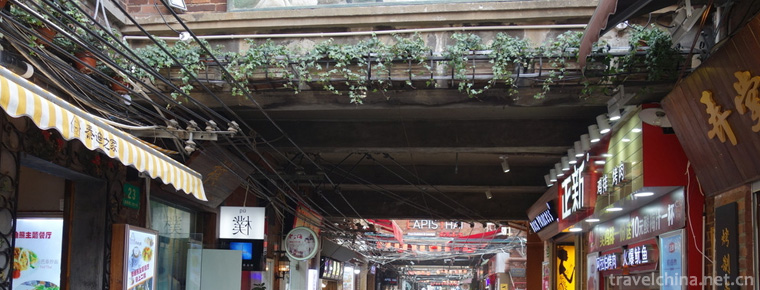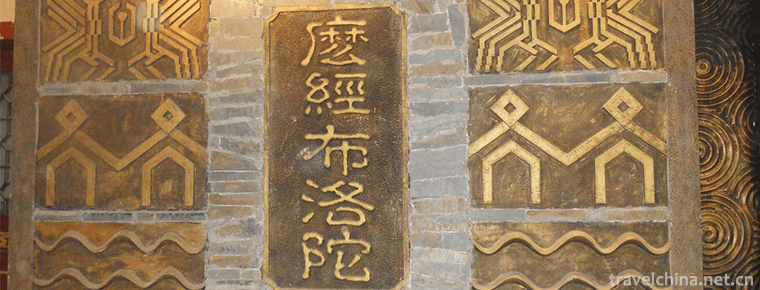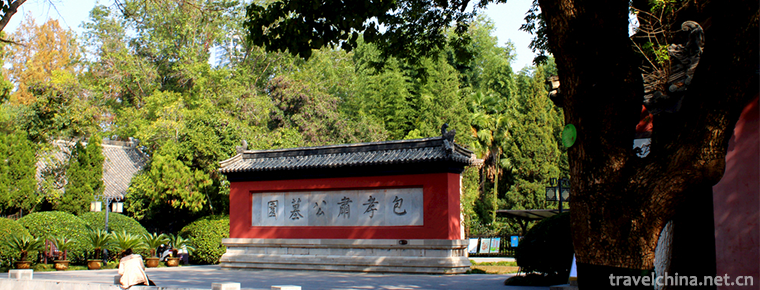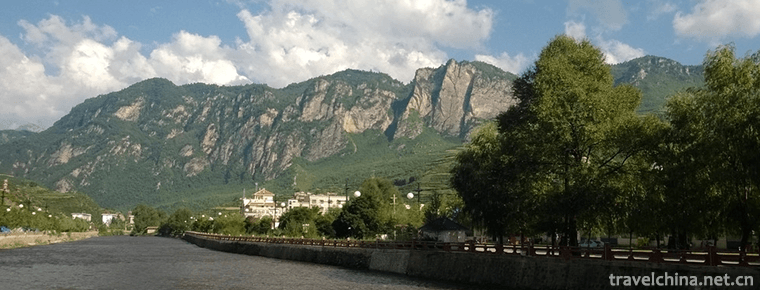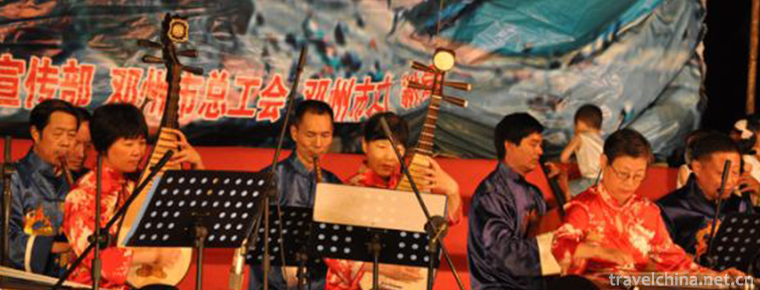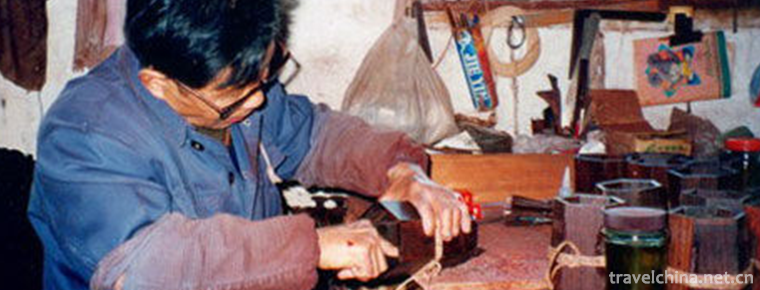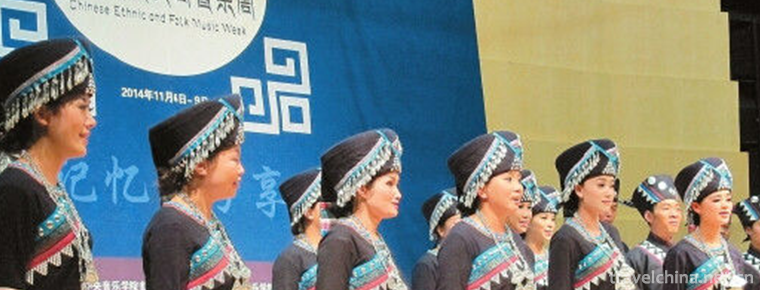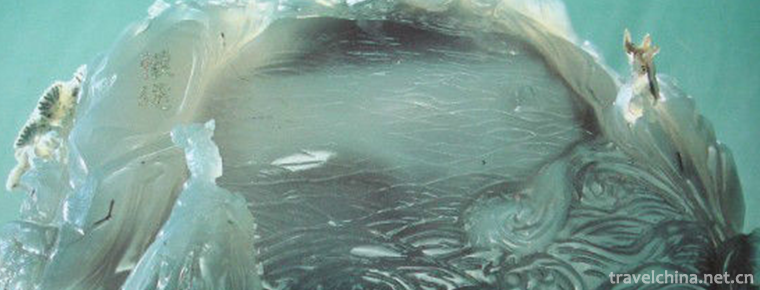Lu Opera
Lu Opera
Luju opera, formerly known as "pour seven operas", is commonly known as "small opera", "prayer and sacrifice opera", "small pour opera", "small barbaric opera", "Lujiang opera". The origin of the name is unknown. Because it was prevalent in central Anhui Province and belonged to Lujiang County of Luzhou (now Hefei City), it was formally renamed Luju Opera on July 1, 1955 with the approval of Anhui Provincial Committee of the Communist Party of China.
Luju Opera is one of the main traditional local operas in Anhui Province. It is prevalent in Lujiang County, West Anhui, a large area along the Yangtze River and parts of the south of the Yangtze River in Anhui Province. Luju Opera is developed on the basis of folk songs in Dabie Mountain and flower lanterns in Huaihe River by absorbing the tunes of Gong and drum books (door songs), Duangong Opera and Hezi Opera.
On May 20, 2006, Luju Opera was approved by the State Council to be included in the first batch of national intangible cultural heritage lists with the heritage number IV-57.
Historical origin
The origin of Luju opera has no historical data. Later, according to a Ming Dynasty "Tu's genealogy" handed down by blind artist Li Ruyao and his own singing, it was recognized by industry experts. So far, the origin of Luju opera is located in Huoshan County, Dabie Mountains.
developing process
Luju opera was first operatized in the Jiaqing period of the Qing Dynasty (around 1800). It coincides with the formation time of Huoshan's "Xiao Opera". At that time, there were mobile performances by professional class clubs. The early Luju opera was based on the folk songs, gate songs (gate words), folk basket dances and flower drum and lantern dances of Dabie Mountain and Huaihe River in Anqing City. The singing tune of its opera "Selling Orchids" is the popular flower drum and lantern tune in the Huaihe River area, while that of "Dasang" is the popular "Dahua Stone Tune" in the Dabie Mountains. At that time, most of the performances used the form of singing and dancing, such as "around the fence", "around the door rotor", "one-stop", "scissors" and "lotus leaf turning over", which were similar to the flower drum lanterns along the Huaihe River. During its development, Luju Opera was influenced by "Hezi Opera" which was popular in Funan of Northwest Anhui Province and Gushi of Henan Province. Later, it absorbed and melted some operas and arias of "Duanggong (Witch) Opera" and other operas in Hubei Huagu Opera and Huaihe Area, which enriched itself continuously, such as "Duangtong" aria and "Xiuxie", "Zhangxianggong Dowry" and so on.“ Duangong Opera","Qian Xue","Tea Picking"and other operas come from Huagu Opera in Hubei Province, and"Huangmei Allegro"(also known as the line tune) singing from Huagu Opera in Southern Anhui Province. In the early stage, the Luju Opera troupe had fewer than 10 people, and could only perform on the grass-roots stage in the countryside. Its repertoires were "Point Barley", "Spring Festival", "Hong Wu Fang Ma", "Xuemei Godfather" and other small life plays. Before and after the Revolution of 1911, he once performed with the Hui opera troupe, which was called "Siping Belt Conversion" ("Siping" refers to the Hui opera, and "folding" refers to the Lu opera minor opera). In the 1930s, some class clubs entered Wuhu, Hefei and other cities to perform. They also worked with Peking Opera, known as the Random Bomb Class. Therefore, Hui Opera and Peking Opera also influence the repertoire and performance.
In 1985, a stone tablet was found in Chaohu City, Anhui Province. On the top of the tablet are inscribed four big characters, "Exhibition in the Orthodox Hall". The inscription, with about 400 words, was banned by Chen Bing in Renzhi County, Chao County. There are four prohibitions, and the second refers to the last seven operas. The discovery of this stone tablet not only proves that the name of the opera has appeared more than 130 years ago, but also provides a more reliable clue to its generation: that is, the age of the opera can be traced back to 1840 (Daoguang and Xianfeng years of the Qing Dynasty).
Representative repertoire
The traditional repertoire of Luju opera can be divided into three categories: Huaqiang Opera, Folding Opera and Benxi Opera. There are 292 statistics.
Coloratura Opera
Most of the Huaqiang operas are two or three, mainly reflecting the working people's livelihood and love. There are also some satirical comedies and farces, such as "selling yarns", "selling groceries", "letting parrots", "Shangzhushan", "borrowing wives", "long-term workers", "scolding chickens" and "picking tea". In addition, there are also some temporary repertoires which reflect the struggle life of the people in the late Qing Dynasty, such as "Cigarette Lighting", which exposes the ugliness of opium ghosts, and "Lower Guangdong" which reflects the peasants'turning to the Taiping Army.
Folding drama
Folding plays are mostly the "gallbladder" (the outstanding part with independence), such as "Tampering Song" in "Sister Zhang's troubles in Tokyo", "Running the Curtain" in "Liang Zhu", "Lai Shi Ji" in "Zhang Taihe's divorce wife" and "Godson" in "Sanyuan Ji". Some come from Hui Opera, Peking Opera or other operas, but through long-term performance in the countryside by Luju opera artists, the characters, feelings and language of the people in the opera are re-shaped, enriched and deepened from the perspective of the main audience, peasants, thus with a strong flavor of life and local characteristics. Folding opera, one is independent, the story is complete, there are ends; one is drawn from the play, can be performed alone, but also together, including "Garden Gun", "Hou Beauty and Fragrance", "Painting", "Shanbo Running Curtain", "Yingtai Dazao" 78.
The play
The main content of this play is family sorrow and joy, love and official cases. Apart from the play's unique "Chaiaxu Ji", "Handkerchief Ji", "Drought Ji", "River God" and so on, it mostly transplants and adapts the legends of Ming and Qing Dynasties, drums and other kinds of plays, such as "Pair of Colorful Towers", "Pipa Ji", "Medicine and Tea Ji", "Meng Jiangnu", "Tianbao Tu" and so on. This opera (including Liantai opera) includes "Xiuxiao", "Qin Xuemei", "Xue Fengying", "Contract Record", "Baiyu Belt", "Flower Selling", "Wujin Record", "Double Ribbons" and "Flower Velvet Record".
Inheritance and protection
Inheritance value
Soil and water on one side and song on the other. Luju opera, because of its fresh tune, distinctive features, and extensive coverage, is very popular with the masses, and Luju opera is regarded as one of the best in Anhui. It has the scent of mountains, the charm of water and countryside, but it integrates a hundred schools of thought into one. Today, Luju opera has gone through more than 200 years of long and arduous years. It is still singing and dancing in the posture, clearly showing the local people's life customs and spiritual features, and making this land can continue to be the same mountain, water, people and emotional sympathy.
Inheritance status
With the acceleration of economic globalization and social modernization, Anhui local operas such as Luju are facing difficulties. At the same time, the survival and development of almost all traditional cultural and artistic forms are facing severe challenges and fierce shocks. There are many reasons for the predicament of the traditional Luju opera, such as the diversity of dialects, the inconsistency of singing tones and the lack of "tune". The external factors include the shrinkage of performance market, rigid management system, inadequate talent training and inadequate propaganda and support. The quality and quantity of Lu Opera works are scarce, most of them are traditional ones. There are few new ones, neither plateau nor peak. The existing performance market is full of cliche, symbolization and fragmentation works.
Luju Opera was very popular in the 1950s and 1980s, but in the late 1980s, due to many reasons such as talent, market, mechanism and investment, the professional Luju Opera troupes in the whole province declined sharply. So far, only more than ten Luju Opera troupes remain, and the situation is not optimistic. On the other hand, private class societies of professional folk Luju opera troupes are flourishing, and they are active in more than 200 popular areas.
Inheriting characters
Wang Benyin, (1906-1990) Xiaoxiao Lock, Xiaozhuang Lock, Wang Sanqiao, Wang Laobun, Luzhou Opera actor, playing Danjiao, originally from Guanjiamiao, Feidong County (now known as Yongan Township). He played the role of Zhu Gongyuan in the pioneering performance of Liang Shanbo and Zhu Yingtai, which was a pioneer in the art reform of Luju Opera. Later, in the shaping of "Luohan Qian" in the carpenter Zhang, the "Qian Xue" in the old gentleman, and has a good reputation in the theatre.
Ding Yulan, actress of Luju Opera. Feidong people in Anhui Province. From an artist's family. When I was young, I learned drama from my father, and when I was twelve, I learned Luju opera from my teacher. Gong Qingyi, Hua Dan. He has performed in central Anhui. He joined Hefei Civilian Opera Society in 1949. After the founding of the People's Republic of China, he was successively an actor of the Northern Anhui Local Opera Experimental Theatre, the Luzhou Opera Troupe of Anhui Province, and an actor, deputy head and honorary head of the Luzhou Opera Troupe of Hefei City. He is good at performing such plays as Xiuxiao, Qin Xuemei's Painting, Jade Hammer Records, Double Ribbons and so on.
Sun Bangdong, from Hefei, Anhui Province. The third batch of national intangible cultural heritage successors. The landmark character of the junior student of Luju Opera took part in work in 1951 and joined the Communist Party of China in 1987. He has served as artistic director of Hefei Luju Opera Troupe, member of China Dramatists Association and member of Hefei Municipal Literary Federation.
Huang Bing was admitted to Hefei Luju Opera Troupe in December 1971 as an actor and acting as a student. He was vice president of Hefei Luju Theater in 2000, director of Anhui Dramatists Association in 2007 and vice president of Anhui Luju Opera Research Association in 2007.
protective measures
Anhui Luju Troupe
Hefei Luju Opera Troupe was a professional artistic performance troupe formed in August 1969 by merging the former Anhui Luju Opera Troupe with the former Hefei Luju Opera Troupe. Anhui Luju Opera Troupe, one of its predecessors, was founded in June 1951 and is the first state-owned theatre troupe in the province. It has successively been called the "Experimental Theatre of Northern Anhui Local Opera", "Anhui Local Theatre Troupe", "Anhui Top Seven Drama Troupe". On July 1, 1955, it was approved by the Anhui Provincial Government to be named "Anhui Luju Opera Troupe".
Hexian Luzhou Opera Troupe
Hexian Luju Opera Troupe is the only county-level professional literary and artistic group in Chaohu City. It has 42 on-the-job performers. It mainly focuses on opera and has a variety of arts. The delegation earnestly implemented the requirements of "close to reality, close to life, close to the masses", and perennially actively carried out literary and artistic activities in urban and rural areas.
major schools
Because of the different regions in Anhui, Luju Opera has formed three ways, namely, the upper, the middle and the lower, that is, three schools.
Shanglu is the West Road, which is popular in Luan, Huoshan, Jinzhai and other areas of Western Anhui. The music is rough and high, ups and downs, with mountain characteristics.
The next road is the East Road. It is popular in Wuhu, Fanchang and Xuancheng in southern Anhui. The music is elegant and graceful, delicate and peaceful, and it has the characteristics of watery villages.
The middle road is centered around Hefei and Chaoxian. Music has the characteristics of both road going and road going. Because its epidemic area is in the ancient Luzhou area of central Anhui Province.
In addition, Shouxian, Huainan and other areas are called "North Road".
social influence
Honorary commendation
On May 20, 2006, Luju Opera was approved by the State Council to be included in the first batch of national intangible cultural heritage lists with the heritage number IV-57.
Important exhibition
On January 1, 2016, Luju Opera debuted at the National New Year Opera Gala.


-
Tianzifang
Tianzifang is located in lane 210, Taikang Road, Shanghai, China.
Views: 174 Time 2018-10-12 -
Buluotuo
Buluotuo, the traditional folk literature of Ganzhuang Mountain in Baise, Guangxi, China, is one of the national intangible cultural heritages..
Views: 203 Time 2018-12-15 -
Package Park
Baoyuan, or Baoyuan for short, is located at 72 Wuhu Road, Hefei City, Anhui Province. It was built in 1063, the seventh year of Jiayou in the Northern Song Dynasty. It was built in memory of Baozheng.
Views: 410 Time 2018-12-26 -
Castle Peak Pass Scenic Spot
Qingshankuan is located in the north of Qianxi County, 40 kilometers away from the county town, located in the Yanshan branch, the hinterland of Daqingshan Mountain..
Views: 192 Time 2019-02-07 -
Silk Strings of Laohekou
Laohekou Silk String is a traditional folk music in Xiangyang City, Hubei Province. Laohekou Silk String is different from other forms of folk literature and art. It is a music that combines folk arti.
Views: 289 Time 2019-05-11 -
Production Techniques of National Musical Instruments
The production of national musical instruments in Suzhou is one of the local traditional handicraft techniques in Jiangsu Province. With a long history, a wide range of varieties, exquisite skills and.
Views: 444 Time 2019-06-05 -
Poop love song
In February 2006, a cultural census unexpectedly found "Poya Ge Shu" in Poya Village. Through expert research, 81 patterns in "Poya Ge Shu" have the character of words, and are one.
Views: 212 Time 2019-06-09 -
Jade carving
Jade carving is one of the oldest carving varieties in China. Jade carved into exquisite crafts, known as jade carving. Craftsmen in the production process, according to the natural color and shape of.
Views: 343 Time 2019-07-16 -
Cognitive Method of Life and Disease in Traditional Chinese Medicine
Cognitive method of life and disease of traditional Chinese medicine, one of traditional Chinese medicine, is declared by the Chinese Academy of Traditional Chinese Medicine and one of the national in.
Views: 158 Time 2019-08-03 -
Schools of Chinese embroidery
Suzhou embroidery has a history of more than 2600 years. It has a considerable scale in the Song Dynasty. In Suzhou, there are xiuyifang, xiuhuanong, gunxiufang and xiuxianxiang. Suzhou embroidery in Ming Dynasty has gradually formed its own unique .
Views: 306 Time 2020-12-12 -
Animal resources in Leshan
The composition of the wild fauna in Leshan City is located in the transitional zone between the Palaearctic realm and the Oriental realm. It is mainly composed of the southwest region and central China region of the Sino Indian subregion in the Oriental realm. .
Views: 335 Time 2020-12-17 -
Dazhou culture
Baqu culture refers to the fact that Dazhou city is located in Bashan canal and belongs to Badi in ancient times. The chapter of Baqu customs is listed in the ancient book Taiping Huanyu Ji thousands of years ago; the second refers to the unique cultur.
Views: 364 Time 2020-12-20
